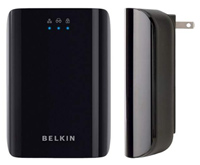Belkin cancels FlyWire wireless HD solution while Atlona releases new wireless USB to HDMI adapter

Sending HD signals through the home wirelessly is one of those Holy Grails that seems to be just outside of the reach of mainstream consumers. One of the slickest-looking solutions that suffered lengthy delays, and from a $1,500 price tag, is Belkin's FlyWire, which used WHDI technologyto beam high-def video to a TV without wires. Such delays in getting a product to market usually signal big problems, and Belkin has finally killed off the project.
Belkin is blaming the cancellation on the sky-high price tag being too burdensome in this economy, though other companies are continuing on with their more-affordable wireless solutions. While the FlyWire was getting shelved, Atlona was introducing the HDAiR, a USB converter that delivers high-def content from your computer to an HDTV using ultra-wide band (UWB) wireless technology. Its cost is just $199. The HDAiR's range is 30 feet, but it only can beam 720p HD signals, not 1080p.
The HDAiR joins Gefen's Wireless HDMI Extender on the market, though Gefen's device can handle 1080p HD and lets you send signals from Blu-ray players and other HDMI-compatible devices. It also costs $999. Sony has its own solution in the $499 Wireless Link Module for its Bravia HDTVs, while Panasonic has introduced the $6,000 Viera Z1 plasma that includes a receiver unit using WirelessHD technology.

Which solution will ultimately win, and when? Let us know your thoughts in the TalkBack section.